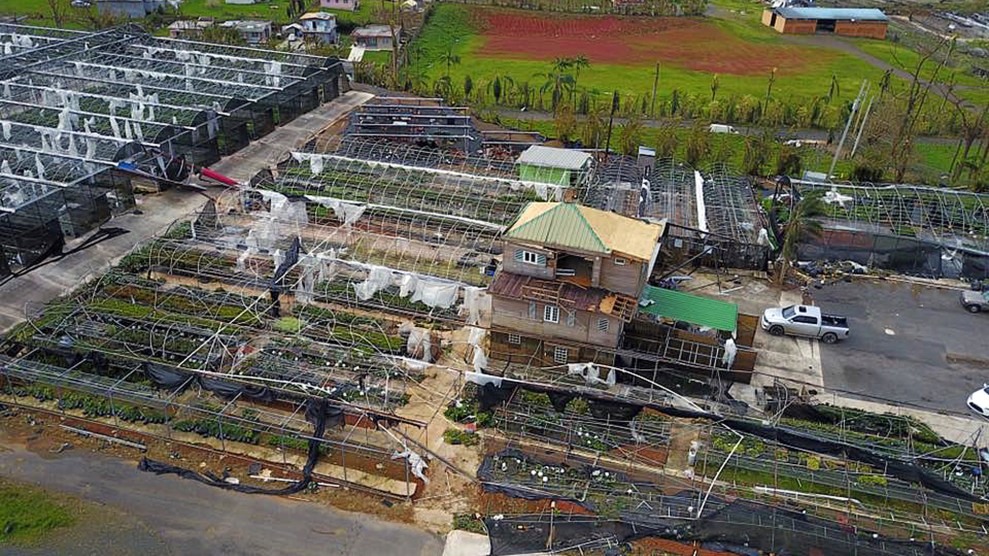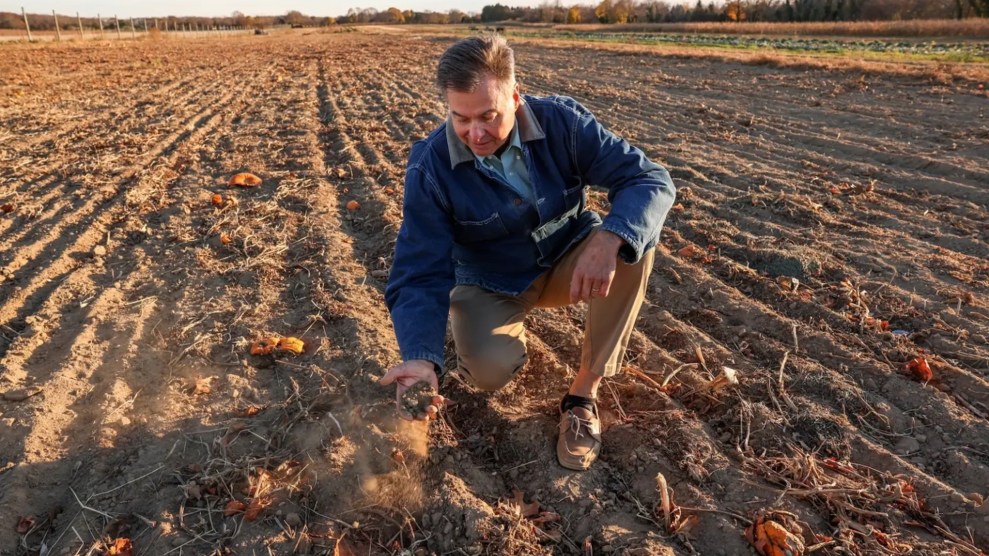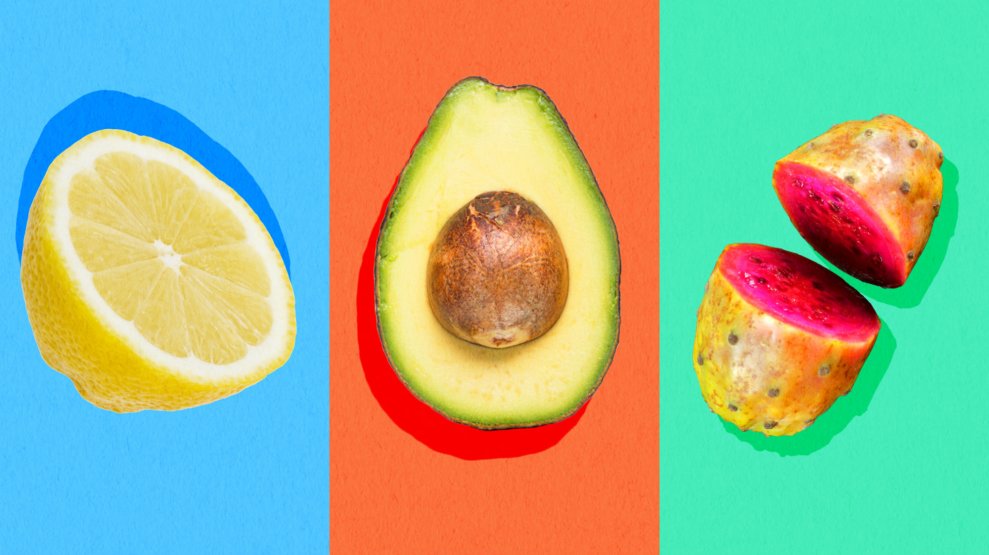
Grist/Armin Staudt/EyeEm/Fridholm, Jakob/Douglas Sacha/Getty Images
This story was originally published by Grist and appears here as part of the Climate Desk collaboration.
Chris Sayer pushed his way through avocado branches and grasped a denuded limb. It was stained black, as if someone had ladled tar over its bark. In February, the temperature had dropped below freezing for three hours, killing the limb. The thick leaves had shriveled and fallen away, exposing the green avocados, which then burned in the sun. Sayer estimated he’d lost one out of every 20 avocados on his farm in Ventura, just 50 miles north of Los Angeles, but he counts himself lucky.
“If that freeze was one degree colder, or one hour longer, we would have had major damage,” he said.
Avocado trees start to die when the temperature falls below 28 degrees or rises above 100 degrees. If the weather turns cold and clammy during the short period in the spring when the flowers bloom, bees won’t take to the air and fruits won’t develop. The trees also die if water runs dry, or if too many salts accumulate in the soil, or if a new pest starts chewing on its leaves. “All of which is quite possible in the next few decades, as the climate shifts,” Sayer said.
The weather had been strange lately, Sayer told me. In the past year, Californians have lived through a historic drought, a massive wildfire that blotted out the sun, and a strangely warm winter followed by that unseasonable freeze. When I visited in April, his lemon trees were already loaded with ripe fruit—that usually doesn’t happen until June. “Things are screwy,” Sayer said.
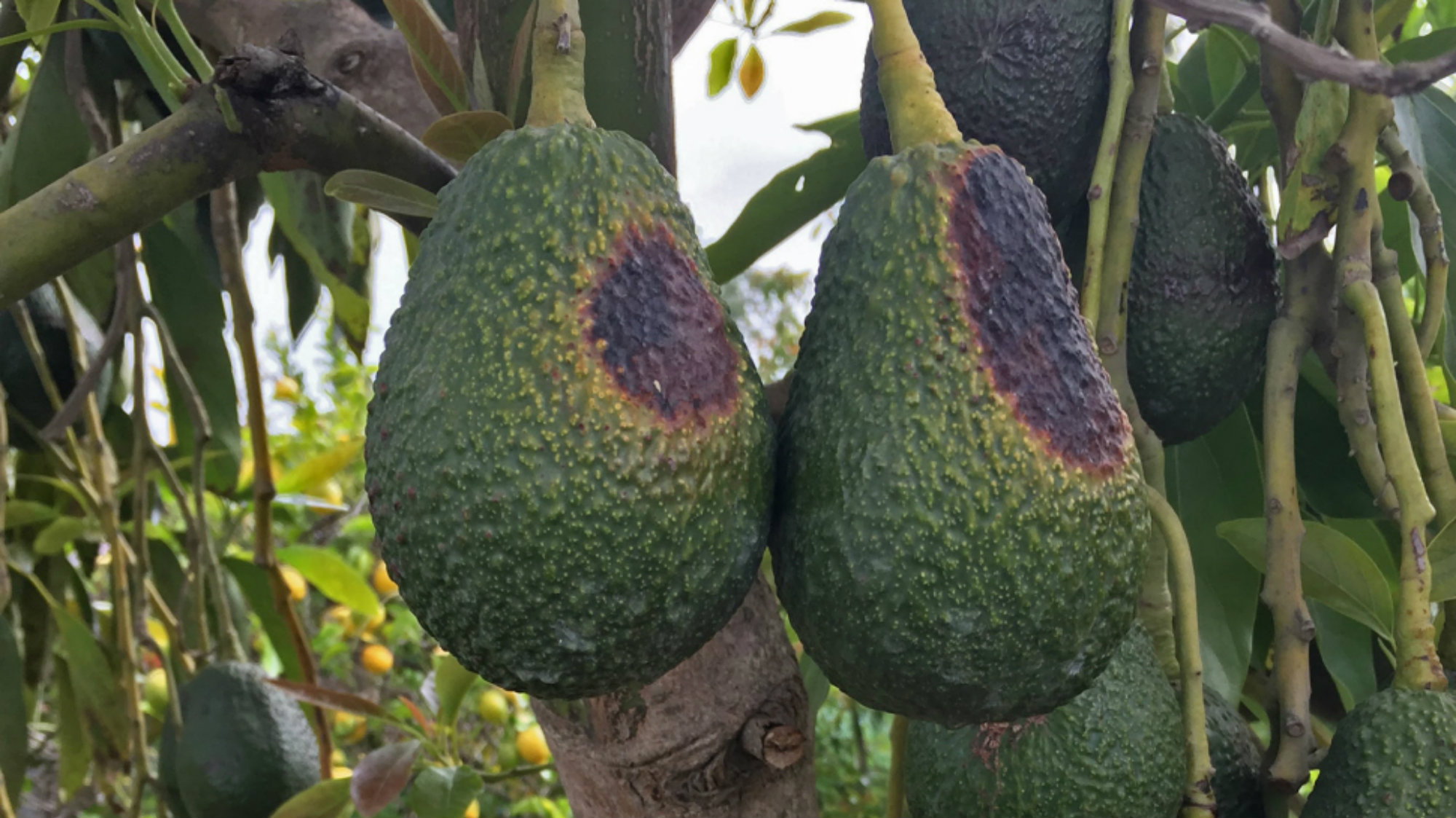
These sunburned avocados could have used some SPF 50.
Grist/Nathanael Johnson
From the vineyards of the north coast to the orange groves of Southern California, farmers like Sayer have been reeling from the weird weather.
“We are already suffering the effects of climate change,” said Russ Lester, who grows walnuts at Dixon Ridge Farms, east of Sacramento. “I can look out my window and see trees that don’t have a leaf on them and others that are completely leafed out.”
“The trees are totally confused.”
It might feel like we’re peering into the distant future when we hear that by 2050, temperatures may very well climb 4 degrees, seas could rise a foot, and droughts and floods will become more common. But for farmers planting trees they hope will bear fruit 25 years from now, that seemingly distant future has to be reckoned with now.
A lot of the country’s tree crops grow in California, which produces two-thirds of the fruits and nuts for the United States. The same is true of grape vines, which bear abundant fruit for about 25 years (they slow down after that, but can keep going for hundreds of years). It’s in large part because so many farmers are making these long-term gambles on orchard crops that a recent scientific paper noted: “Agricultural production in California is highly sensitive to climate change.”
Jay Famiglietti, the senior water scientist at NASA’s Jet Propulsion Laboratory in Pasadena, California, goes even further: “It’s a virtual certainty that California will get drier. I don’t think it’s a climate that’s conducive to orchard crops anymore.”
In other words, for anyone trying to make money off long-lived crops, climate change is already here. And yet new saplings are pushing out of the ground all over the state.
If these farmers were planting an annual crop, like cilantro, they’d be making a bet on the weather for the next 45 days. But they’re planting trees, which means making a bet on the next 40 years.
After years of putting it off, Sayer is about to place such a four-decade bet by planting a bunch of new avocado trees. There’s no way Sayer can foresee oncoming climate disaster, if that’s what’s hurtling toward the land his family has worked for the past 130 years in Ventura. He can see just a little bit of what might be coming—as if he’s straining to glimpse signs of danger while blinkered. When I asked him how it felt, he said: “Like I’m about to cross a very busy road with my hood pulled over my head.”
When Katherine Jarvis-Shean was a doctoral candidate researching the decline of cold winters a few years back, she thought more farmers should be freaking out. “I used to think, ‘Why aren’t you guys more worried about this? It’s going to be the end of the world.’”
After all, many fruit and nut trees require a good winter chill to bear fruit. But after spending a few years as an extension agent for the University of California—working directly with farmers and translating science into techniques they can apply on the land—she understands better. It comes down to this: Farmers have a ton of concerns, and the climate is just one of them.
“If you decide what to plant based on climate, but then can’t make the lease payment, that’s not sustainable,” Jarvis-Shean said.
If you are worried about water running out in 15 years, you might think it’s a good idea to cut down half the state’s almond groves—but if those almond trees are still putting money in your pockets, that wouldn’t make sense until the killer drought hits. That’s the crux of the matter for Sayer, and other farmers I interviewed. They’re concerned about the changing climate, but they always come up with ingenious plans to adapt to bad weather. It’s much harder for them to adapt to an overdrawn bank account.
Sayer grows mostly lemons right now, but they’re not long for this world. “You can see these lemon trees are getting a little rangy looking,” Sayer said, gesturing toward a leafless branch. “This is going to be their last harvest, then they’ve got a date with the chipper.”
Sayer knows lemons. He knows how to coddle them in old age, how to nudge them to produce more, how to keep them alive when rains fail, how to protect them from aphids and snails and scale insects and the nematodes in the ground. But this land has provided a home to a citrus orchard for 70 years, and each year more pests accumulate to suck the life from the trees. So Sayer needs to move on from lemons, and he’s settled on avocados.
From a climate perspective, the leather-skinned fruit are a risky choice. Avocado trees like their surroundings not too hot and not too cold, and they always need water. One study estimated that climate change would hurt California avocado trees so much that the state’s production could be cut in half by 2050.
As the sun burned off the marine layer of clouds over the orchard, Sayer patiently laid out the reasoning that led him to plant avocado trees. He explained that climate poses risks that are easy for outsiders to see—when you’re reading about historic droughts in the newspaper and driving past acres of withered crops, it seems crazy to plant orchards. But farmers often have to contend with other risks that outweigh the danger of bad weather. Sayers puts them into three categories: climate risk, market risk, and execution risk.
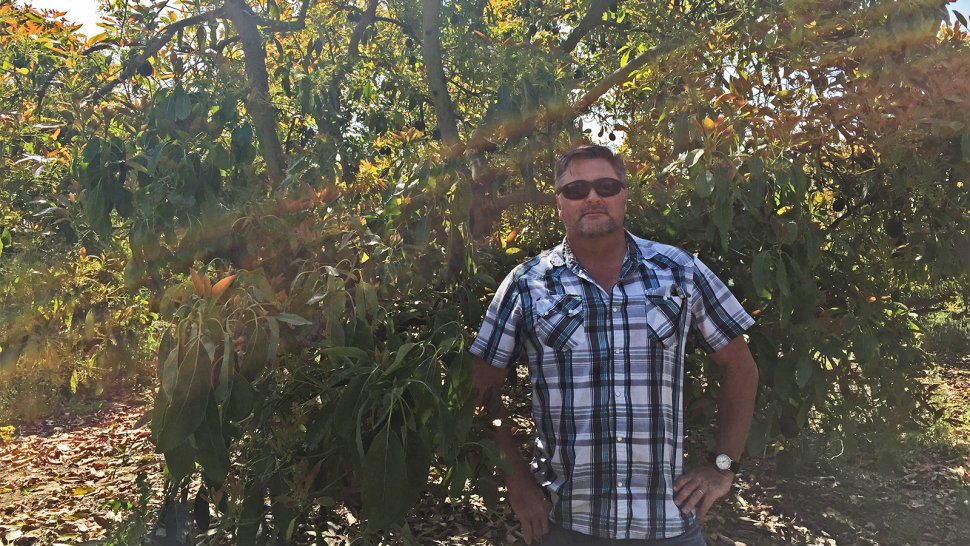
Chris Sayer.
Grist/Nathanael Johnson
If he were only worried about climate risk, Sayer said, he’d plant prickly pear. “They would grow in any post-apocalyptic hellscape you could imagine,” he said. But who would buy them? Most Americans don’t put prickly pear on their shopping lists. So there’s a huge market risk.
Then there’s execution risk: the chance that Sayer screws things up. If he didn’t have to worry about that, Sayer might follow his neighbor’s lead and start growing annual crops. He pointed across the road from his farm, where orchards once stood, at a flat expanse of strawberries dotted with hustling pickers. There’s always an appetite for strawberries, and they’re cheap to plant, so they pose a low market risk. And because strawberries get planted every year, they’re not such a big gamble on the changing climate. If a freak storm kills everything growing in Ventura, for instance, Sayer’s neighbor would lose that year’s strawberry crop while Sayer would lose a 30-year avocado investment.
But the execution risk of switching to strawberries—figuring out how to grow them, buying the right equipment, and learning how to sell them—is too high for him. “We’re talking about years of learning,” Sayer said. “It would be like me deciding to go back to college to study medicine.” He’s 52, and not prepared to start fresh.
Sayer has one other option that would eliminate all the climate, market, and execution risks: Pave his farmland and build houses. When I visited in April, workers were constructing apartments on what used to be farmland at the end of his street. If more farmers start taking climate risks seriously, a surge of subdivisions could start sprawling across some of the most fertile farmland on the planet. But the thought of that saddens Sayer. He wants to farm.
After weighing all those risks, he decided to bet the farm on avocados. These trees are no climate savior—far from it. But Sayer been experimenting with them for decades and understands how they work. He knows he can sell avocados, because he’s tapped into a network that reserves spots for the fruit in every grocery store, and turns sunburned avocados into frozen guacamole. Also, you might have noticed the market is strong: Americans are chowing down so much avocado tonnage in new, creative ways — smoothies, toast, ice cream, you name it—that consumption has increased sevenfold since 2000.
Orchards can endure weird weather brought on by climate change, but if they don’t get any water, the trees will die. In the past, California farmers have always survived droughts by sticking deeper and deeper straws into the ground to suck up groundwater. But since 2014, the state has had a law against depleting aquifers, and farmers soon won’t be able to take out more water than goes in.
That policy alarms growers, especially since they can no longer depend on snow in the Sierra Nevada Mountains. Mountains hold water—in the form of glaciers—through the colder months, then release it during the warmer months. But as the climate heats up, more of the precipitation that fell in California as snow will turn to rain. That means more floods in winter and more droughts in summer.
To adapt to this boom-and-bust cycle, a few farmers around California are letting swollen rivers spill into their orchards. If carried out on a large scale, this would slow down rushing flood waters and let them percolate into aquifers.
After four years of experimentation in almond groves, scientists have found that this inundation hasn’t hurt the trees. They’ve also identified nearly 700,000 acres under almond trees suitable for recharging groundwater, said Richard Waycott, president of the Almond Board of California. At the same time, growers continue to use less freshwater for irrigation and draw more water recycled from city drainpipes.
In another example of climate adaptation, farmers are developing a kind of hyper-local climate engineering, spraying clay dust over their trees to create shade and cool them down in unseasonably hot weather, according to David Zilberman, an economist at the University of California, Berkeley. Elsewhere, scientists have planted a pistachio orchard where no self-respecting pistachio farmer would ever put a tree: in the middle of the Southern California desert near Coachella.
Most pistachio trees grow 200 miles north, where colder winters allow them to settle into their natural cycles. But in a few decades, that traditional pistachio land could have the climate of Coachella. It’s a type of time travel; the idea is to find a version of the future that already exists.
The pistachio trees aren’t at all happy in the desert: “It’s just terrible out there,” said Craig Kallsen, another extension agent for the University of California. “It looked like someone had irradiated the place with toxic chemicals.”
All the same, a few pistachio trees are beginning to produce leaves. By growing this orchard in this analogue of the climate future, researchers like Kallsen can see which varieties stand up to heat, and then zero in on the genes that allow those trees to adapt. Using those genes, researchers hope to breed trees that can thrive in a hotter, drier world.
Sayer is also adapting by growing different varieties of avocados, but the most visible climate adaptation in the orchard was the knee-high carpet of grasses and turnip stems we waded through as we made our way among the trees.
“Back in the 1970s, bare dirt between the rows was considered clean and tidy,” Sayer said. “If you had a blade of grass sticking out, oh man, that wasn’t good.”
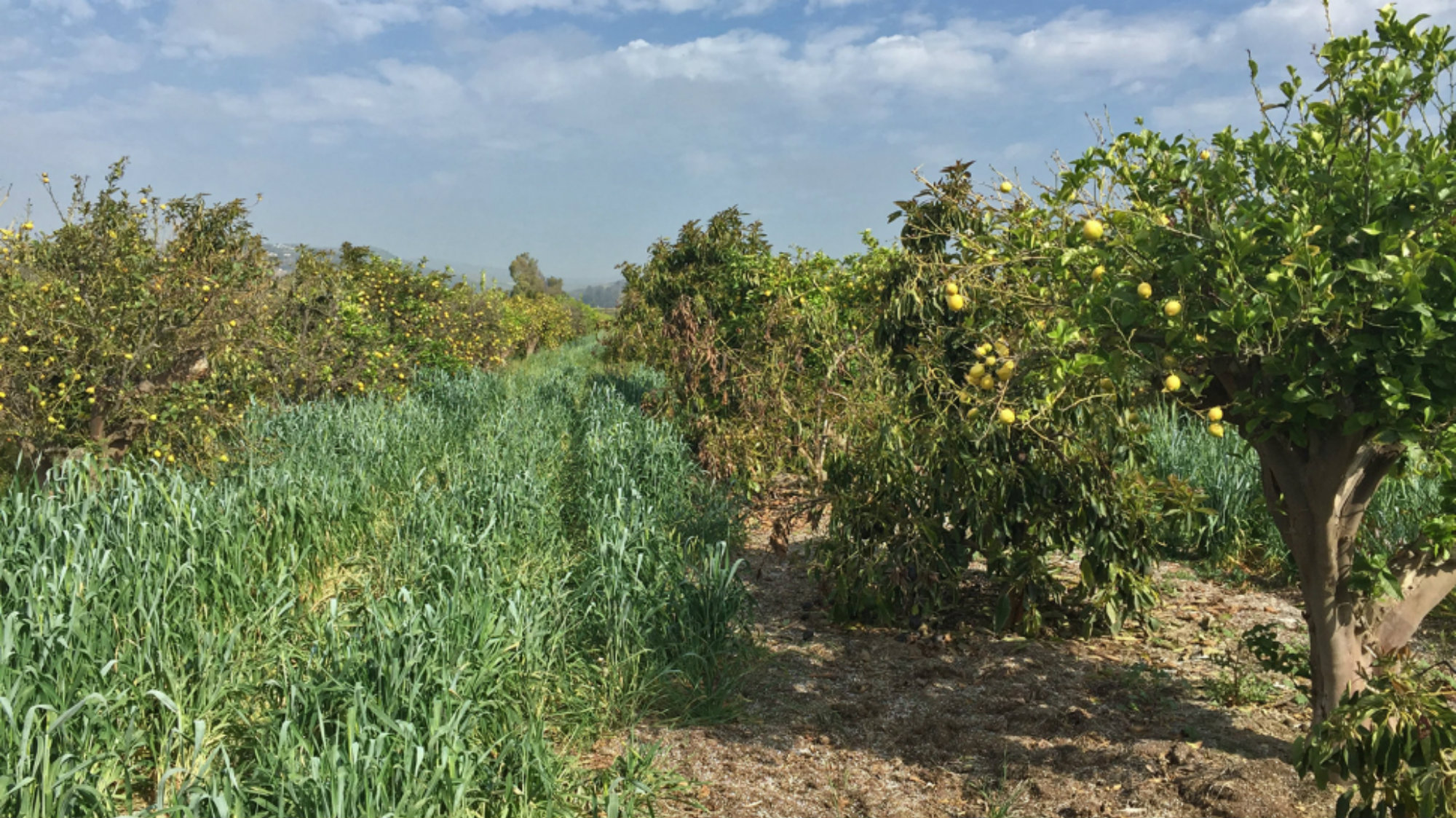
Hip-high cover crops.
Grist/Nathanael Johnson
Letting plants grow beneath the trees seemed like a squalid, lazy, weed-spreading hazard. When he and his father first began planting between the rows in 2005, it felt taboo. Other farmers would sidle up to them at the coffee shop and ask in an undertone, “What’s going on with your orchard? Is that a cover crop?”
A cover crop protects the soil from heavy rains and helps turn it into a habitat for worms, beetles, and thousands of microbes. As we walked through the dappled sunlight, the ground beneath my feet was yielding like a giant sponge.
Sayer has calculated that, since first planting the cover crop, his lemon orchard can absorb 2.5 million gallons more water in a downpour. “Since every scenario I’ve seen involves water stress, better soil is going to put us in a better position, because it holds and absorbs more rain,” he said.
Lester, the Sacramento-area walnut grower, also plants cover crops. And he has an audacious justification for planting new trees: He hopes to reverse climate change.
Cover crops pull carbon from the air into the soil and—if we can figure it out—all of agriculture could become a giant carbon-dioxide sponge. Lester powers his operation with solar panels and a walnut-shell burning furnace (releasing carbon his walnut trees recently sucked out of the air), making his farm carbon negative.
“Call me optimistic, but I believe if all farmers adopted healthy soils technology, agriculture can play a huge role in stopping, slowing down, maybe even reversing climate change,” Lester said.
Not all farmers are as scientifically literate as Lester or Sayer; many shrug off climate change as just another shift in the weather. But even the ones who readily accept the science of climate change continue to plant trees. Perhaps they are overly optimistic. Perhaps they are just human: It’s not in our nature to ignore threats right in front of our face so we can focus on those in the seemingly far-off future.
After I’d spent the day with Sayer, his decision to plant more avocados made sense: It’s the choice that allows him to keep farming. He’s making preparations based on the best climate projections he can get, while also setting himself up to react to the unexpected. He can see a path to profitability, though he allows that his vision into the future—in terms of both climate and weather forecasting—is severely restricted.
If you recall, he likened planting a new round of avocado trees to crossing a busy road with a hood over his head. There was a second part to that analogy: “At least I know which way to look for the oncoming traffic.”


